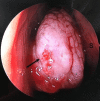Solitary Fibrous Tumour: A Rare Differential Diagnosis of Unilateral Nasal Mass
- PMID: 37128528
- PMCID: PMC10148597
- DOI: 10.7759/cureus.36901
Solitary Fibrous Tumour: A Rare Differential Diagnosis of Unilateral Nasal Mass
Abstract
Solitary fibrous tumors of the nasal cavity and paranasal sinuses are rarely encountered in clinical practice. These are unusual mesenchymal tumours initially described as primary spindle-cell neoplasms. Such tumours may manifest in pleural and extrapleural sites such as the liver, parapharyngeal space, sublingual and parotid glands, and thyroid but are seldom described in the nose and paranasal sinus region. Erosion of adjacent structures may occur, but the tumour itself does not metastasise. A young patient presented with a progressive unilateral nasal mass. The initial nasal biopsy reported it as a benign inflammatory nasal polyp. Imaging revealed a large, locally expansile mass within the right nasal cavity displacing the nasal septum. The patient underwent excision of the tumour and the diagnosis of solitary fibrous tumour was confirmed by immunohistochemistry staining. This case is intended to highlight the diagnosis and management of this rare tumour.
Keywords: benign inflammatory nasal polyp; nasal cavity; nasal obstruction; paranasal sinus; solitary fibrous tumour.
Copyright © 2023, Chew et al.
Conflict of interest statement
The authors have declared that no competing interests exist.
Figures




Similar articles
-
Solitary Fibrous Tumor of Nasal Cavity: A Case Report.Iran J Otorhinolaryngol. 2015 Jul;27(81):307-12. Iran J Otorhinolaryngol. 2015. PMID: 26788480 Free PMC article.
-
Solitary fibrous tumor of the nasal cavity and paranasal sinuses: A case report.J Oral Biol Craniofac Res. 2015 May-Aug;5(2):112-6. doi: 10.1016/j.jobcr.2015.04.001. Epub 2015 Jun 29. J Oral Biol Craniofac Res. 2015. PMID: 26258025 Free PMC article.
-
Minimally invasive endoscopic techniques for treating large, benign processes of the nose, paranasal sinus, and pterygomaxillary and infratemporal fossae: solitary fibrous tumour.J Laryngol Otol. 2009 Apr;123(4):457-61. doi: 10.1017/S0022215108002132. Epub 2008 Apr 11. J Laryngol Otol. 2009. PMID: 18405404
-
Solitary fibrous tumour of the nasal cavity and paranasal sinuses.Acta Otolaryngol. 2003 Jan;123(1):71-4. doi: 10.1080/003655402000028052. Acta Otolaryngol. 2003. PMID: 12625577 Review.
-
Sinonasal Tract Solitary Fibrous Tumor: A Clinicopathologic Study of Six Cases with a Comprehensive Review of the Literature.Head Neck Pathol. 2018 Dec;12(4):471-480. doi: 10.1007/s12105-017-0878-y. Epub 2017 Dec 27. Head Neck Pathol. 2018. PMID: 29282671 Free PMC article. Review.
References
-
- Solitary fibrous tumor of the buccal space. Dunfee BL, Sakai O, Spiegel JH, Pistey R. https://www.ajnr.org/content/26/8/2114.long. AJNR Am J Neuroradiol. 2005;26:2114–2116. - PMC - PubMed
-
- Solitary fibrous tumors of the pleura. De Perrot M, Fischer S, Bründler MA, Sekine Y, Keshavjee S. Ann Thorac Surg. 2002;74:285–293. - PubMed
-
- Solitary fibrous tumor of the nasal cavity and paranasal sinuses. Morales-Cadena M, Zubiaur FM, Alvarez R, Madrigal J, Zarate-Osorno A. Otolaryngol Head Neck Surg. 2006;135:980–982. - PubMed
-
- Primary neoplasms of the pleura. A report of five cases. Klemperer P, Coleman BR. Am J Ind Med. 1992;22:1–31. - PubMed
Publication types
LinkOut - more resources
Full Text Sources
